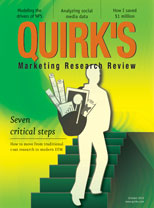Editor's note: Michael Vigeant is president and CEO of GreatBlue Research Inc., Meriden, Conn. He can be reached at mjv@greatblueresearch.com. This article appeared in the October 14, 2013, edition of Quirk's e-newsletter.
Are your employees satisfied? It's a deceivingly simple question. Off the cuff, most would answer yes. Aside from Friday afternoon grumblings around the water cooler, it's probably pretty quiet. And no news is often seen as good news when gauging employee satisfaction.
But is it really?
When an organization does not actively reach out to its employees to monitor satisfaction, opportunities are missed. Employees are at the center of all customer interactions so in trying to deliver the ideal customer experience, organizations benefit most from first exceeding employee expectations. Employee satisfaction drives internal and external well-being, as a unified and positive company culture carries over into customer interaction.
When employees are happy, driven and empowered, customers sense these traits and respond favorably. If the customer service representative can go above and beyond to provide issue-resolution immediately without having to go through several other managerial channels, the customer is the ultimate winner. When an employee sits down each morning with a smile before reaching out to clients, his optimistic outlook becomes a company trait.
So how do you assure employees are putting their best face forward? Research. Ask them what is working, understand their pain points and respond. Utilizing employee satisfaction surveys, companies can gauge internal potential for both success and decline. Employee satisfaction data measures the following components:
- Key motivators. Maybe money is not what your employees need for validation. Other options might be growth, company culture, encouragement, leadership or education. Without asking what drives these individuals, how can you ever meet or exceed their expectations?
- Levels of empowerment. Employees who feel armed to help customers are much more likely to follow through. When employees feel confident they can handle situations, customers get immediate results and validation that the organization wants to help.
- Company education. A broad look at what employees know about the organization and offerings will provide insight into additional skills or information needed and highlight employees or departments best prepared for next steps and responsibilities.
- Basic needs. When employees feel well-equipped, they can provide for customers more quickly. Whether office supplies or training, knowing what employees lack allows management to respond.
- Communication preferences. The HR department spends hours a month on the internal newsletter - is anyone reading it? What about the Friday reminders from accounting? Understanding how and when to reach employees allows your organization to cut out costly ancillary tasks and focus on efficiency.
Efficient in customer impact
Employee satisfaction surveys present management a multitude of opportunities to improve company culture, working conditions and employee outlook. After aligning internal company efforts, the next step is looking outward to the consumer and ensuring these improvements are efficient in customer impact. Customer satisfaction surveys are the next logical step. Just as data provided the backbone for internal development, research is crucial in customer outreach.
In an ever-changing technological environment, opportunities for communication are practically limitless. Through e-mail surveys, bulletin board discussion groups and focus groups, companies can understand customer contact needs, desires and preferred channels. There are five pivotal components of communication.
Who
Outlining the key demographics of an organization's customer base provides fruitful insight into preferred methods of communication, potential groups for targeted marketing and ideal candidates for direct connection.
What
Understanding the type of information customers seek is important. Would they be interested in a monthly informational newsletter or do they prefer only receiving promotions? Knowing what to send establishes rapport and increases appreciation for the information presented.
When
Customers lead fast-paced and hectic lives, so identifying the best moments to reach out for feedback or new offerings can boost employee productivity and sales while also demonstrating sincere respect for a customer's time.
Why
While brand messaging is important, even more so is creating a positive customer experience. Determine why customers want to hear from your company to capitalize on these calls to action.
How
Are your customers on social media? Are they confident using chat support? Will you have better luck cold-calling landlines or going back and forth on Twitter? Data can pinpoint how and where to reach the target market.
Building blocks
The building blocks of an outstanding customer experience begin with measuring the satisfaction of the staff. Market research is the key to setting your organization up for success and presenting an ideal customer experience rooted in the confidence that a capable and empowered employee is available in the exact moment and way your customers need them.
